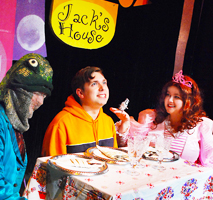From Time Out Chicago Kids
January 27, 2012
By Web Behrens
Known for its adaptations of children’s tales, Lifeline’s KidSeries presents an original story this time around: How to Survive a Fairy Tale, a whimsical, metafictional look at fables. Ensemble member and playwright James E. Grote serves up a cute story about a kid named Jack, whose childhood is bereft of fairy tales. What’s more, Jack doesn’t even know what he’s missing; his dad reads to him from manuals at bedtime. (Among funny touches that help keep adults engaged: Jack is especially fond of a how-to-assemble instruction booklet from IKEA.) Young Jack is a bit suspicious of his parents, however, as well he should be: His mom is a princess, and Dad’s a giant frog.
Therein lies the crux of this family’s problem: Jack’s parents were cursed by a witch but they can’t figure out how to undo the spell. Meanwhile, Jack is whisked off to a magical land of talking wolves and bears and billy goats gruff when a strange book bonks him on the head.
Whaddya know: It’s a book of fables! Which gives Jack an advantage — he can read ahead to find out what’s about to happen — as he tries to navigate this dangerous new world, filled with wink-wink updates on classic characters. Little Red Riding Hood, for example, can’t be bothered to take off her headphones and stop watching TV. If she did, then she’d realize that Granny’s in Big Bad Wolf-related danger.
Director Shole Milos and his game cast of five, all playing multiple roles except Nathaniel Niemi, precocious as Jack, have fun with Grote’s script, adding exaggerated accents for extra helpings of silly. Goldilocks is a Southerner; Hansel and Gretel are German.
Best of all, Fairy Tale tosses a few clever curveballs to its younger audience members by twisting the stories that they already know, to embed little life lessons. Thanks to Jack’s help, Goldilocks learns a thing or three about hospitality. The Witch relinquishes her diet of Child Stew to become a vegetarian. Jack discovers that the troll is actually a good guy, and that the goats gruff are jerks who torment him for no good reason. The troll’s name is Gurblet, and actor Jacquis Neal plays him with hilarious, Redd Foxx-esque verve.
If you’ve never been to one of Lifeline’s KidSeries shows before, Fairy Tale offers a fine introduction. While not a big-budget production, it emphasizes imagination and enthusiasm. The show features some great lighting and sound effects, and costumes by Jana Anderson. Alone worth the reasonable price of admission is a madcap chase sequence for Little Red, Granny, the Wolf and Jack, which brings the energy of Looney Tunes cartoons to life before your very eyes.
From Chicago Theater Beat
A delightful tale for all ages
January 8, 2012
By K.D. Hopkins
I am of the opinion that children are a lot smarter than we presume. I always questioned the logic of stories like “Goldilocks and the Three Bears” or “Jack and The Beanstalk.” Those Goldilocks and Jack always seemed to be troublemakers with no respect for grown folks. You never ate at a stranger’s house much less with a family of bears! Lifeline Theatre’s production of How to Survive a Fairy Tale tells the story from more of a real world perspective with a knowing wink to the adult audience.
We are introduced to Jack and his parents, who just happen to be a Princess and a Frog. Nathaniel Niemi is thoroughly charming and appealing as Jack. It seems perfectly normal that his mom wears a tiara and pink tulle and that his dad has a big green scaly head. Jack’s parents keep him away from fairy tales to protect him from the truth about the world. Heather Currie, playing Jack’s Mom, Grandma, Mama Bear, and several other characters, is side-splittingly funny, using her body and voice for full comic effect. It is worth the price of the ticket to see her as Red Riding Hood’s Grandma in red Dr. Denton skivvies and a night cap. The chase that ensues with the Huntsman, Red, Jack, and the Big Bad Wolf is beautifully timed and punctuated by a pitch perfect damsel in distress scream from Currie.
Playwright James Grote takes neorealist approach to the characters’ portrayals — but with some modern touches. Grandma has the ‘rheumatiz’ and watches ‘The Real Princesses of the Enchanted Forest’ in an arch nod to the public fascination with so called reality television. A sound bite of Snow White dissing Cinderella is heard in the background. It is a nice shout out to ‘Real Housewives’ fans (me included). In fact, the play gives a satirical elbow in the side to how female characters have always been written and continue to be portrayed. Amanda Link takes on the Herculean task of bringing some childhood favorites to vivid and almost surreal life. Her Goldilocks, Red, and Gretel are a double-entendre delight. Goldilocks is a ditzy Scarlett O’Hara who runs the gamut from fiddle-dee-dee to a snoring nap on Baby Bear’s bed. One of the biggest laughs comes from Jack questioning the sanitary consequences of using the same spoon to snarf down Baby’s porridge.
Link’s Red is a blithe mixture of naiveté and modern smarty pants. The kids in the audience really enjoyed Red’s response to Grandma’s suddenly wolfish breath. The interplay between Link and Jacquis Neal is priceless as Hansel and Gretel. The candy stealing moppets are right out of a Jolie/Farrow adoption brood. Link dons a milk maid wig and Neal is a Black Hans in lederhosen. Neal is also a perfectly grouchy Bridge Troll who is really misunderstood and actually has a name — Gerblet.
In another fairytale turn, Jack realizes that the Billy Goats Gruff were the trouble makers and not the fluffy innocents of lore. The Gruffs are portrayed as a bit tarter than the petting zoo variety. Gerblet is just trying to live in peace in the shelter of the bridge, and the goat hooves are like thunder overhead. They stomp over the bridge and tap dance and jeer at Gerblet. The goats are like thugs destroying a crabby man’s lawn. It is a good lesson about respecting others and co-existence as well as standing one’s ground. Jack points out that the stories don’t have to end with lurid violence. This re-visioning doesn’t pander to saccharine kumbayas but the scarier characters like the Troll and the child-eating Witch are rehabilitated quite nicely. It’s the happily ever after of modern times.
The wonderful cast also includes Derek Czaplewski as Jack’s amphibious Dad, the Huntsman, and one of the Gruff Gang who ends up in the river from a well-aimed book of fairy tales.
Having reviewed many of Lifeline Theatre’s productions over the years, it’s hard to imagine a company with richer production values and consistent attention to detail. With Fairytale, the set design is simple but still plays an integral part of the story with this exquisite ensemble. Costume designer Jana Anderson weaves sumptuous colors and textures to give this whimsical journey a fantasy look that is essential for a fairy tale. This story has enough of the moral edge of the really not-so-jolly stories. Fairy tales are often dark with really grisly violence. There are evil women with their heads literally put to the grindstone, self- dismemberment (Cinderella’s stepsisters were a trip), and weird relationships (read anything by Hans Christian Anderson).
Nathaniel Niemi as narrator and common sense savvy kid is the perfect hero for this fairy tale. He is the best Jack of them all. Forget Be Nimble, Little Jack Horner and the plum, or that dork with the beanstalk. Jack and Gerblet have franchise potential. Take the kids or the adults to see this, and banish cabin fever for a while!
From Centerstage
January 17, 2012
By Alex Huntsberger
Lifeline Theatre’s “How to Survive a Fairy Tale” is a fun, meta-farcical take on classic fairy tales that makes sure everyone, young and old, leaves the theatre satisfied.
Jack (a wide-eyed Nathaniel Niemi) has never read a fairy-tale; he’s grown up being read to from cookbooks and Ikea assembly manuals by his parents, the Princess (Heather Currie) and the Frog (Derek Czaplewski). So when Jack happens upon a book of fairy tales and is magically transported to the Enchanted Forest, he must travel through Red Riding Hood, Goldilocks and other fairy tales until he can find a way home. Luckily for him, he still has the book, which allows him to predict, avoid and alter the tales’ outcomes.
The script, by James E. Grote, is a good-natured commentary on fairy tale norms that invigorates the original stories even as it winkingly undermines them. Each of Jack’s tips for surviving a fairy tale offers a tidy lesson for the play’s ethically impressionable target demo and the play goes light enough on the pop culture references that when they do come, they are surprising and welcome.
The cast, rounded out by Amanda Link and Jacquis Neal, is a game lot, with everyone but Niemi playing multiple roles. Some of the performances can blend into one another, but there are many notable highlights, like Czaplewski’s Brawny Man Woodsman, Link and Neal’s Teutonic Hansel and Gretel, and a delightfully WASPy take on Goldilocks’ three bears.
Lifeline’s production is pretty bare bones, with Alan Donahue’s basic, versatile unit set staying out of the way but not doing much to enhance any individual scene, Meanwhile, Jana Anderson’s costumes are right on target: the characters look exactly how one pictures them. However, the real standout for this production is Anthony Ingram’s enchanting, pervasive soundscape, which does a lot of heavy, but subtle, lifting.
When the show was over and the audience was filing out, I heard a child thank their grandparent for taking them to the show. If you bring your children to see “How to Survive a Fairy Tale” I’m sure they’ll tell you the very same.
From the Chicago Sun-Times
Fairy tales have plenty to say at Lifeline
January 4, 2012
By Jennifer Burklow
Lifeline Theatre’s Kid Series steps out of its comfort zone — producing literary adaptations for families &mdash: with “How to Survive a Fairy Tale” opening Jan. 7 at the Rogers Park venue. “Fairy Tale” is not an adaptation. It’s the first original play written by one of Lifetime’s go-to adaptors, ensemble member Jim Grote, who first started doing adaptations in 2000. Grote figures he’s done eight or nine Lifeline adaptations since then, for both adults and families.
Known for his collaborative musical productions created with composer/lyricist George Howe — “Click, Clack Moo: Cows That Type,” “Dooby Dooby Moo” and “Duck for President” — this time Grote is flying solo. “Fairy tale” is not a musical.
“It is my first original work,” Grote said. “And that really is the challenge. The flipside of not doing an adaptation is cool, because you can do what you want — but terrifying because you can do anything you want… So it’s been a challenging process because I don’t have an outline,” which literary adaptations provide.
“How to Survive a Fairy Tale” is about a kid named Jack whose parents are a princess and a frog. Because their fairy tale did not turn out as it should have, they shield Jack from fairy tales. Although well-read — the family library contains tomes on all manner of subjects — Jack knows nothing about fairy tales. In his home they are verboten.
One night Jack’s parents go out and a book that Jack has never seen before beckons to him from the bookshelf. As Jack reaches for the book it bonks him on the head, sending him into a deep sleep. He awakens in a forest in the middle of the “Red Riding Hood” saga. The play evolves into a madcap romp through fractured versions of “The Three Bears,” “Three Billy Goats Gruff” and “Hansel and Gretel.” Jack learns a survival tip or two in each fairy tale, and in the end those tips allow him to solve his parents’ dilemma.
Grote’s script was inspired by the Neil Gaiman poem “Instructions,” which he heard during a Lifeline ensemble meeting. The poem explores the mythical worlds of fairy tales and nursery rhymes.
“It just kind of got the wheels going in my head,” Grote said. He thought, “Wouldn’t it be interesting if you had a kid who had no knowledge of fairy tales and was suddenly thrust into that world and how would he deal with it?”
Grote’s biggest goal is for his audience to simply enjoy the show and its subtle message.
“I hope [the kids] giggle their heads off,” Grote said. “We’ve got some great physical comedy. I think it’s going to be fun for them to see fairy tales in kind of a different light. The actor who is playing Jack is very charming and I think they’re going to be able to identify with him and be like, ‘Oh, how would I survive these fairy tales? What would happen if I were thrust into this world?’ I think there is a bit of an empowerment to it of you know — Jack does survive all of these things and he helps out his parents at the end of the story by being creative and using some of these things that he learned.”

















